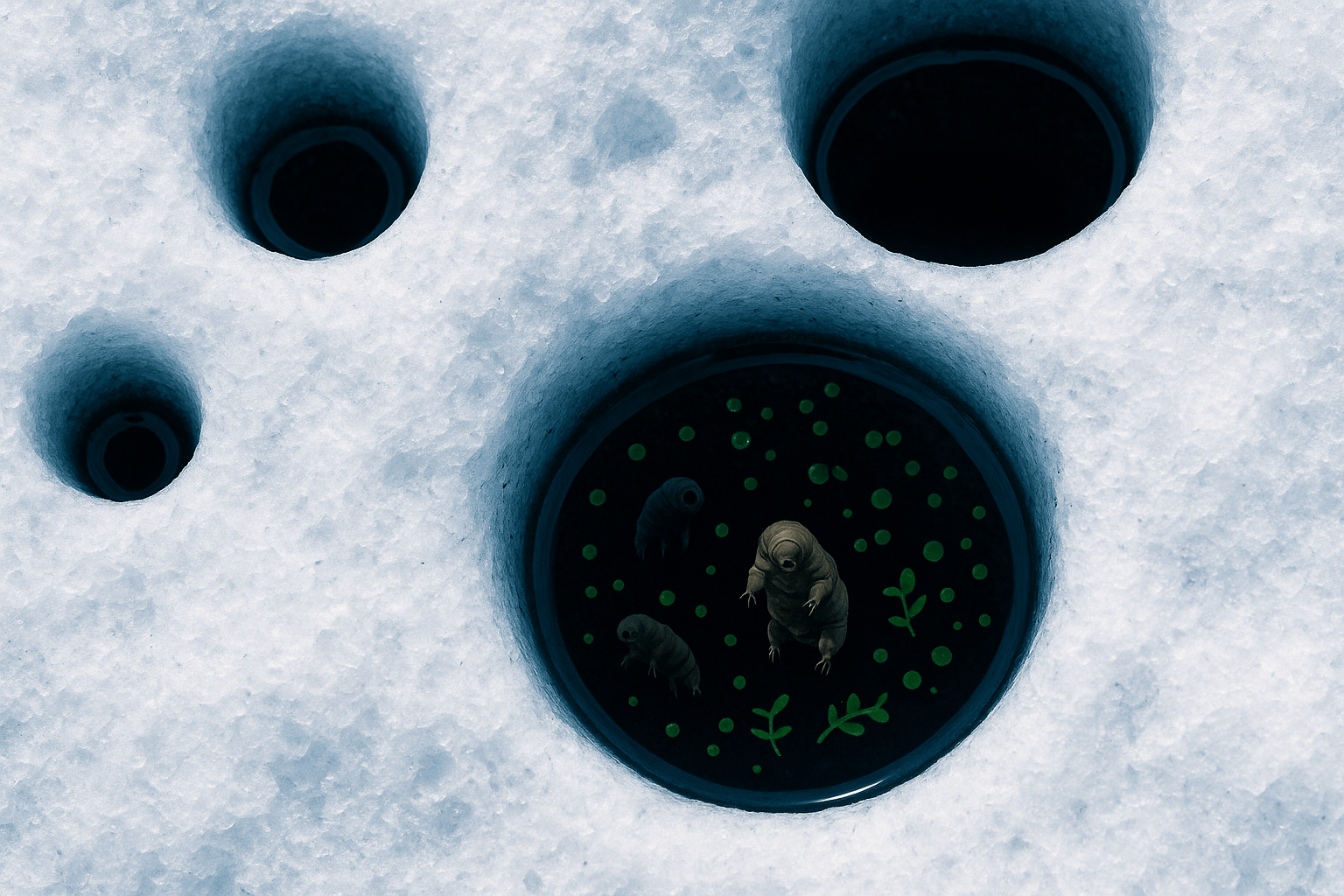What is a Cryoconite Hole? A Lesson in Physical Geography
To understand these miniature ecosystems, we first need to understand their formation, a perfect case study in physical geography. The process begins with cryoconite itself—a mouthful of a word derived from the Greek ‘kryos’ (cold) and ‘konis’ (dust). This dark, granular material is a cocktail of wind-blown particles: fine rock dust from distant mountain ranges or deserts, soot from wildfires and industrial pollution, and even extraterrestrial micrometeorites.
When this dark dust lands on the reflective white surface of a glacier, it triggers a fundamental physical process related to albedo, which is the measure of how much solar radiation a surface reflects.
- High Albedo: The pristine white ice reflects most sunlight, keeping the surface frozen.
- Low Albedo: The dark cryoconite granules absorb sunlight, converting it into heat.
This absorbed heat melts the ice directly beneath and around the granules, creating a small pocket of liquid water. As the dust sinks into this meltwater, it continues to absorb heat, drilling a cylindrical hole deeper into the glacier. These holes can range from a few centimetres to over a metre in diameter and depth, creating a stable, water-filled habitat insulated by the surrounding ice—an oasis of life in a frozen desert.
Life in the Cold: A Microscopic Serengeti
Despite the near-freezing water temperatures, cryoconite holes are hotspots of biodiversity. They are some of the simplest, most isolated ecosystems on Earth, making them invaluable laboratories for scientists studying the fundamental rules of life. Inside each hole, a surprisingly complex community thrives:
- Primary Producers: At the base of the food web are microbes, particularly cyanobacteria and algae. These organisms use photosynthesis to convert sunlight into energy, forming gooey, granular mats that bind the cryoconite particles together. They are the foundation of the entire ecosystem.
- Grazers and Predators: Feeding on this microbial bounty is a host of microscopic animals. Chief among them are rotifers and tardigrades (also known as “water bears” or “moss piglets”). These incredibly resilient creatures are famous for their ability to survive extreme conditions, from total dehydration to the vacuum of space. Nematode worms also slither through the sediment, completing a simple but functional food web.
This entire world—producers, consumers, and decomposers—exists within a puddle of water that you could hold in your hands. It’s a complete, self-sustaining biological community, locked away in the ice.
A Global Phenomenon: Mapping the Micro-Worlds
Cryoconite holes are not restricted to one remote corner of the globe. They are a widespread geographical feature found on glaciers and ice sheets worldwide. Their distribution tells a story of global atmospheric circulation and geological activity.
In Greenland, the vast ice sheet is peppered with them. Dust from Asian deserts and soot from North American and European industry travels thousands of miles to land here. In Antarctica, cryoconite holes in the McMurdo Dry Valleys host some of the only life found for miles. Alpine glaciers, from the European Alps near cities like Zermatt, Switzerland, to the remote peaks of the Himalayas in Nepal and the Andes in Peru, all feature these tiny ecosystems. Researchers based in places like Svalbard, Norway, use cryoconite holes as accessible models to understand how polar ecosystems might respond to climate change.
The Human Fingerprint: A Tale of Human Geography
While some cryoconite material is natural, a significant and growing portion bears the signature of human activity. This is where the study of cryoconite holes transitions from physical to human geography. The dark soot particles within the cryoconite are often traceable to the burning of fossil fuels from power plants, vehicles, and factories located in industrial centres hundreds or thousands of kilometres away. Increased frequency and intensity of wildfires, a phenomenon linked to anthropogenic climate change, also release vast plumes of black carbon that settle on the ice.
A cryoconite granule found on a glacier in Greenland could contain particles from a wildfire in Canada, a factory in Europe, and desert dust from the Gobi Desert in Asia. It is a physical record of the interconnectedness of our planet’s systems, demonstrating how actions in a densely populated city can have tangible consequences in the most remote, sparsely populated regions on Earth.
A Darkening Planet: The Feedback Loop Accelerating Melt
Beyond being fascinating micro-worlds, cryoconite holes play a critical and alarming role in a dangerous feedback loop. Each dark hole reduces the glacier’s overall albedo, acting like a tiny solar panel that accelerates local melting. As the climate warms, more of the glacier surface melts in the summer, exposing and concentrating cryoconite particles from previous years and providing more liquid water for the biological communities to grow.
This growth darkens the holes even further—a process called bioalbedo feedback. More microbes mean darker sediment, which means more heat absorption, which means more melting, which supports even more life. When multiplied by millions of cryoconite holes across an entire ice sheet, this effect becomes a major geographical phenomenon. The “darkening” of the Greenland Ice Sheet, in particular, is now a significant factor in its accelerating melt rates. This melt contributes directly to global sea-level rise, threatening coastal cities and communities from Miami to Mumbai.
What begins as a microscopic speck of dust becomes part of a global process, linking a tiny ecosystem to the fate of coastlines worldwide. The cryoconite hole is a stark reminder that on our planet, nothing exists in isolation. These miniature worlds, hidden in plain sight on our glaciers, are not just a curiosity—they are a critical indicator and an active agent in the story of our changing climate.
